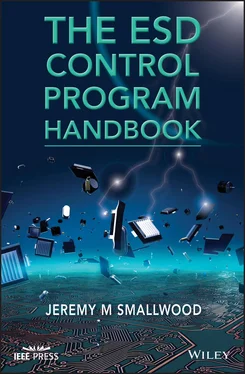The susceptibility of the ESDS device to peak current, power, energy, waveform, and other parameters of the discharge through it varies between devices.
The ESD current path through the ESDS component may be through parts that have different damage thresholds.
The ESD event may not be sufficiently strong to exceed the damage threshold of its path through the component.
So, ESD may occur many times during handling or processing a component, without ESD damage occurring. The probability of ESD damage occurring may be one in hundreds or thousands of ESD events. Combine this with the fact that damage will be discovered often at a much later manufacturing stage, and may not be identified as due to ESD, it is small wonder that many people get the impression that ESD damage is something that does not happen to them!
Nevertheless, each time that a conductor contacts an ESDS component is an opportunity for ESD to occur. Given sufficient ESD opportunities and insufficient ESD control, ESD damage becomes inevitable.
2.10.3 The Principles of ESD Control
The principles of ESD control are remarkably simple. Each principle is aimed at reducing a particular ESD risk.
ESDS are handled only within an electrostatic discharge–protected area (EPA; see Chapter 4) or under ESD‐controlled conditions. This ensures that when ESDS devices are handled, the ESD risks are controlled to an acceptable level.
Outside the EPA in unprotected areas (UPAs), ESD protective packaging is used to protect the ESDS device. The packaging is designed to prevent ESD sources outside the package from having a significant effect on the ESDS device within the package. It also provides a safe region within the package in which ESD risks are controlled.
Within the EPA, ESD risks are controlled by eliminating as far as is possible the sources of ESD likely to damage the ESDS.
Conductors that may touch an ESDS, especially metal items and people, are grounded wherever possible. This ensures that as far as possible, electrostatic voltages on conductors are the same and near zero. This is to prevent them from becoming charged and a source of significant ESD to ESDS devices.
Where conductors cannot be grounded and might contact an ESDS, the voltage difference between the conductor and the ESDS device must be reduced to a sufficiently low level to prevent significant ESD risk.
Electrostatic fields that may occur near ESDS devices are eliminated or reduced to a low level. Insulators that may become charged and the source of electrostatic fields are, where possible, removed from the vicinity of ESDS devices. This is to reduce the risk of induced charging of isolated ESDS devices or other ungrounded conductors.
Items that may contact an ESDS device are preferably made from materials that have appreciable electrical resistance. If ESD occurs, this helps to reduce discharge current to a safe level and absorb much of the discharge energy within the material rather than in the ESDS device.
These measures do not eliminate ESD but help reduce the numbers of ESD occurring, the magnitude of any ESD that occurs, and the likelihood of it damaging the ESDS. Reducing the number of times contact is made with an ESDS device can also help reduce the likelihood of ESD damage occurring. So, the simple measures of not handling the ESDS device any more than necessary and reducing to minimum contact between the ESDS device and other conductors that might be at different voltage can make a useful contribution to reducing ESD risk. If the materials are resistive rather than low resistance where they contact ESDS devices, then a further reduction of risk of ESD damage is made. This is due to reduction of peak current in the discharge and absorption of energy by the resistance of the material.
Suitably specified ESD protective packaging can reduce the risk of ESD damage occurring in the UPA to an insignificant level. The packaging must be specified to address the ESD risks appropriate to the ESDS component or item.
1 Agarwal, A. and Lang, J.H. (2005). Foundations of Analog and Digital Electronic Circuits. Morgan Kaufmann, ISBN 1‐55860‐735‐8.
2 Andersson, B., Fast, L., Holdstock, P., and Pirici, D. (2008). Charging of a person exiting a car seat. Electrostatics 2007. J. Phys. Conf. Ser. 142: 012004.
3 Bailey, A.G., Smallwood, J.M., and Tomita, H. (1991). Electrical discharges from the human body. In: Electrostatics –Inst. Phys. Conf. Se. 118 Sec. 2. Inst.Phys.
4 Barnum, J.R. (1991). Sandia's severe human body electrostatic discharge tester (SSET). In: Proc. EOS/ESD Symp. EOS13, 29–30. Rome, NY: EOS/ESD Association Inc.
5 Cross, J.A. (1987). Electrostatics Principles, Problems and Applications. Adam Hilger. ISBN 0‐85274‐589‐3.
6 Department of Defense. Military Handbook. (1994) Electrostatic Discharge Control Handbook for protection of electrical and electronic parts, assemblies and equipment (excluding electrically initiated explosive devices) (metric). MIL HDBK‐263B. Washington DC, Department of Defense.
7 International Electrotechnical Commission. (2013) PD/IEC TS 60079‐32‐1. Explosive atmospheres Part wp2‐1. Electrostatic hazards, guidance. Geneva, IEC.
8 Jonassen N. (1985) The physics of air ionization. In: Proc. EOS/ESD Symp. EOS‐7 Minneapolis USA. Rome, NY, EOS/ESD Association Inc. pp. 59–66.
9 Jonassen, N. (1986). The physics of air ionization. In: Proc. EOS/ESD Symp. EOS‐8, 35–40. Rome, NY: EOS/ESD Association Inc.
10 Jonassen, N. (1998). Human body capacitance – static or dynamic concept? In: Proc. EOS/ESD Symp. EOS‐20, 111–117. Rome, NY: EOS/ESD Association Inc.
11 Kelly MA, Servais G E, Pfaffenbach T V. (1993) An Investigation of Human Body Electrostatic Discharge. 19th International Symposium for Testing & Failure Analysis Los Angeles, California, USA. Russell Township, OH, ASM International.
12 Kuffel, E., Zaengl, W.S., and Kuffel, J. (2001). High Voltage Engineering. Newnes ISBN 0 7506 3634 3.
13 Landers, E.U. (1985). Distribution of charge and fieldstrength due to discharge from insulating surfaces. J. Electrostat. 17: 59–68.
14 Norberg, A. (1992). Modelling current pulse shape and energy in surface discharges. IEEE Trans. Ind. Appl. 28 (3): 498–503.
15 Norberg, A. and Lundquist, S. (1991). A distributed RC transmission line model for electrostatic discharges from insulator surfaces. In: Inst. Phys. Conf. Se. 118, 269–274. Electrostatics 1991.
16 Norberg, A., Szedenik, N., and Lundquist, S. (1989). On the pulse shape of discharge currents. J. Electrostat. 23: 79–88.
17 Pirici, D., Rivenc, J., Lebey, T. et al. (2003). A Physical model to explain electrostatic charging in an automotive environment: Correlation with experimental approach. In: Proc. EOS/ESD Symp. EOS‐25, 161. Rome, NY: EOS/ESD Association Inc.
18 Simco Ion (2019) Emitter point maintenance. Technical note TN‐003. Available from: https://technology-ionization.simco-ion.com/DesktopModules/Bring2mind/DMX/Download.aspx?command=core_download&entryid=112&language=en-US&PortalId=0&TabId=145[Accessed 16 April 2019]
19 Smallwood, J.M. (1999). Simple passive transmission line probes for electrostatic discharge measurements. In: Inst. Phys. Conf. Se. 163, 363–366. Electrostatics 1999, Inst.Phys.
20 Tamminen P, Viheriäkoski T, Ukkonen L, Sydänheimo L (2015) ESD and Disturbance Cases in Electrostatic Protected Areas. In: Proc EOS/ESD Symp. 5B.2, Rome, NY, EOS/ESD Association Inc.
21 Verhage, K., Roussel, P.J., Groeseneken, G. et al. (1993). Analysis of HBM ESD Testers and specifications using a 4th order lumped element model. In: Proc. EOS/ESD Symp, 129–137. Rome, NY: EOS/ESD Association Inc.
22 Viheriäkoski T, Peltoniemi T, Tamminen T (2012) Paper 4A3. Low Level Human Body Model ESD. In: Proc. EOS/ESD Symp. Tucson Ariz. USA. Rome, NY, EOS/ESD Association Inc.
Читать дальше












